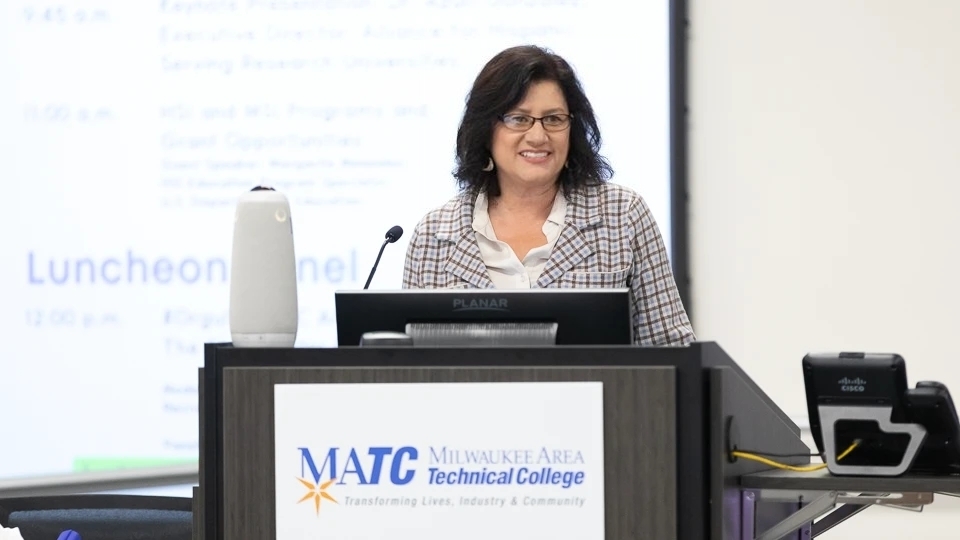
We have work to do but I am hopeful. MATC is a very promising place to be.
MILWAUKEE – Milwaukee Area Technical College should feel like home for Hispanic/Latino/a students – a welcoming place where they can learn, succeed and transform their lives.
And the college has made considerable progress in creating that belonging environment, MATC administrators said on Friday, September 15, at the college’s second annual HSI Day of Engagement.
In the fall of 2018, the college set the strategic goal of becoming an HSI, or Hispanic-Serving Institution, through the U.S. Department of Education. As an HSI, MATC would have access to additional federal money for programs and services. To earn the designation, among other criteria, MATC’s enrollment must be at least 25% Hispanic/Latino/a students.
The college’s Hispanic/Latino/a enrollment was 16.4% in the fall of 2017, 18.5% in the spring of 2022 and now stands at 19.6%, said Patricia Torres Nájera, Ph.D., MATC’s executive director of strategic initiatives, including HSI.
MATC’s goal is to reach 25% by 2024.
“We have work to do but I am hopeful,” Dr. Torres Nájera said at the HSI event held at MATC’s Downtown Milwaukee Campus to kick off Hispanic Heritage Month. “MATC is a very promising place to be.”
MATC has more than 3,200 Hispanic/Latino/a students and nearly half of them are in Healthcare Pathway programs, she said.
To attain HSI designation, Dr. Torres Nájera said the college has teams of faculty and staff working to increase MATC’s visibility in the community, hire more Hispanic/Latino/a faculty and staff, and recruit more Hispanic/Latino/a students and nurture their success while they are at the college.
“Many students go through their entire educational experience and never see anyone who looks like them,” Dr. Torres Nájera said.
Creating a familiar and responsive environment is important to becoming a true HSI, said Azuri Gonzalez, Ed.D., executive director of the Alliance of Hispanic Serving Research Universities, who was the keynote speaker at the HSI event.
Students need access to programs, to communicate in common languages, and feel validated and encouraged, she said. Colleges must eliminate barriers, create an atmosphere of inclusivity, expand opportunities, change what doesn’t work and have culturally responsible leadership, she added.
“An HSI is a place where students can be who they are and how they feel they need to be,” Dr. Gonzalez said. “They should feel seen. To serve your students, you need to know your students.”
Hispanic/Latino/a enrollment in higher education is expected to exceed four million students by 2026, surpassing the growth rate of any other racial or ethnic group by more than 10%, according to the Hispanic Association of Colleges and Universities (HACU).
Also, Hispanic/Latino/a students earned one out of four (25.4%) associate degrees conferred in 2021, compared to 13.2% in 2011, the association said.
The HSI program started in 1992, when Congress formally recognized schools with high Hispanic/Latino/a enrollments and made federal funds available to those campuses.
Today, 571 institutions have met the federal HSI enrollment criterion, including 226 public two-year colleges. Wisconsin has three: Alverno College, Herzing University in Kenosha and Mount Mary University.
Another 400 schools in the state have attained Emerging HSI status: MATC, Beloit College, Carthage College, Gateway Technical College, Marquette University, Milwaukee Institute of Art & Design and University of Wisconsin-Parkside.
To attain full HSI designation, MATC will need help from the community and the city, said Eva Martinez Powless, Ph.D., who was recently named MATC’s interim vice president for enrollment and retention.
“We can’t be an HSI in a silo,” Dr. Martinez Powless said. “We need to collaborate with our partners across the district, the region, the state and the nation. We need to work together to accomplish this important work.”
Learn more about MATC’s HSI initiative
About MATC: Wisconsin’s largest technical college and one of the most diverse two-year institutions in the Midwest, Milwaukee Area Technical College is a key driver of southeastern Wisconsin’s economy and has provided innovative education in the region since 1912. More than 28,000 students per year attend the college’s four campuses and community-based sites or learn online. MATC offers affordable and accessible education and training opportunities that empower and transform lives in the community. The college offers more than 180 academic programs — many that prepare students for jobs immediately upon completion and others that provide transfer options leading to bachelor’s degrees with more than 40 four-year colleges and universities. Overwhelmingly, MATC graduates build careers and businesses in southeastern Wisconsin. The college is accredited by the Higher Learning Commission.

